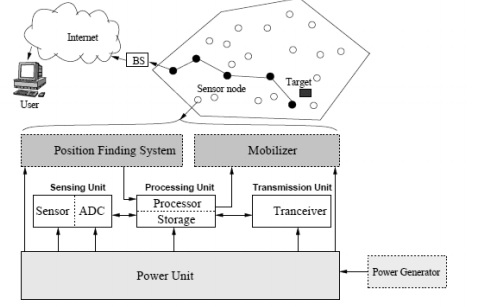
 Data Structure
Data Structure Networking
Networking RDBMS
RDBMS Operating System
Operating System Java
Java MS Excel
MS Excel iOS
iOS HTML
HTML CSS
CSS Android
Android Python
Python C Programming
C Programming C++
C++ C#
C# MongoDB
MongoDB MySQL
MySQL Javascript
Javascript PHP
PHP
- Selected Reading
- UPSC IAS Exams Notes
- Developer's Best Practices
- Questions and Answers
- Effective Resume Writing
- HR Interview Questions
- Computer Glossary
- Who is Who
What are wireless sensor networks?
Wireless sensor networks (WSNs) have the power of distributed communication, computing, and sensing features. They are characterized as infrastructure less, fault tolerant and self-organizing networks which provide opportunities for low-cost, easy-to-apply, rapid and flexible installations in an environment for various applications
The wireless sensor and the sensor node architecture are given in the diagram below −

Characteristics of WSN
The characteristics of WSN are as follows −
Resource constraints − Nodes of WSN are smaller in size and get power from the batteries. It justifies that service provided by the nodes like communication and computation amount of memory is very limited.
Communication paradigm − The data centric feature of WSN explains its data centric nature and justifies that the communication is restricted to nodes.
Application specific design − WSN is application specific i.e. the architecture of WSN is based on application.
Node failure and unreliable communication − Various factors like harsh operating conditions leading to instability, unpredictability, nodal mobility, environmental interferences makes typical WSN nodes to be error-prone.
Scalability and density − The number of nodes in WSNs may be large and densely deployed to a higher degree in various applications.
Dynamic Topologies − Nodes are free to travel randomly at different speeds in few applications and sometimes may fail to operate, to add or to replace. So there can be different network topology.
Communication models − WSNs use different communication models − Flat/ hierarchical /distributed WSNs; or homogeneous/ heterogeneous WSNs.
Operating Environment
The WSNs are mostly deployed in remote and hazardous locations for unattended operations because of their ability to withstand harsh environmental conditions.
Requirements of WSN
The requirements of WSN are explained below:
Flexibility − The architecture of WSN is not fixed. Rather it varies from application to application which justifies that the protocols and algorithms have the characteristics of self-organization.
Fault tolerance − The nodes in WSNs have the capability to sustain the functions carried out in the network even in situations like limited battery power, interference from external sources, failure rate of nodes, harsh environmental conditions.
Lifetime − The two major factors that should be taken into consideration are load balancing and energy saving. These two factors can enhance the lifetime of the WSN architecture as long as possible.
Scalability − The number of nodes in a WSN network can be large. Accordingly WSN architecture and protocols should be designed.
Real-time − The Various capabilities like sensing, processing and communication of WSN are used in various real-world problems so should follow stringent time.
Security − For example in health care data and military data, the data offered by WSN network are private which are sensitive in nature. So security is evident in such architectures.
Production cost − The cost of nodes in WSN network has to be low as once the nodes run out of the energy it has to be replaced by newer nodes.
Deployment − In large-scale WSNs, there is random deployment of nodes whose maintenance and replacements are not practically possible. So there is a huge requirement of re-configuration and re-programming.
Dependability − One can rely on WSN as the architectural design is robust that leads to secure collection of data and reliable delivery with no loss.

